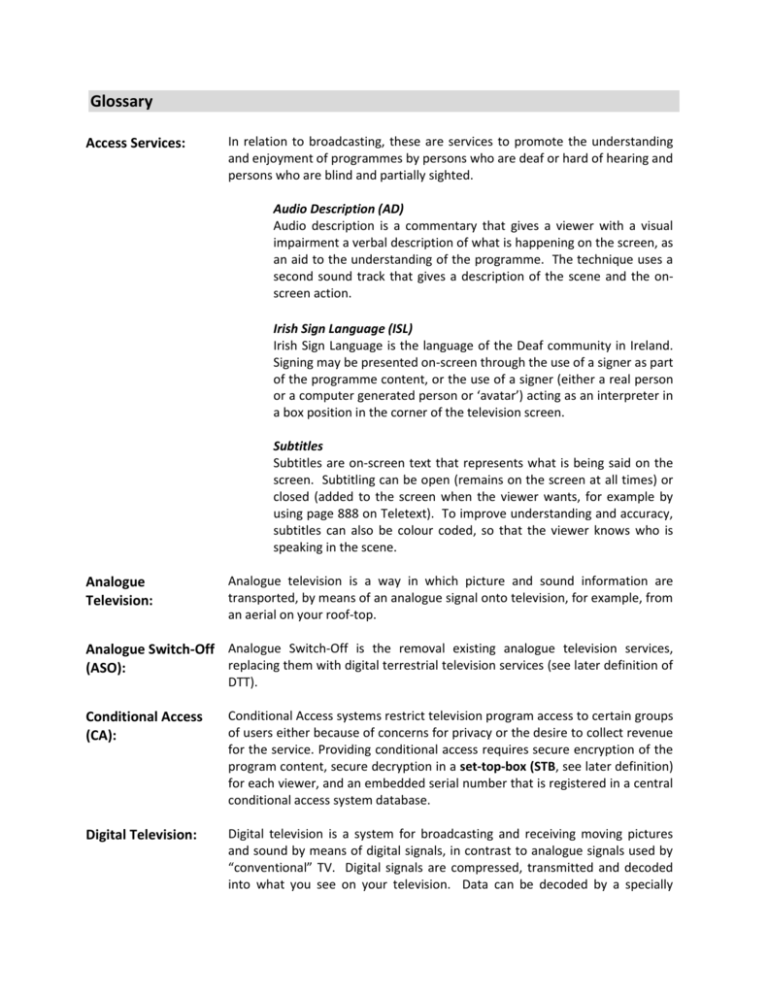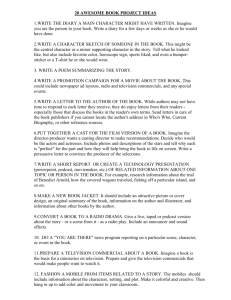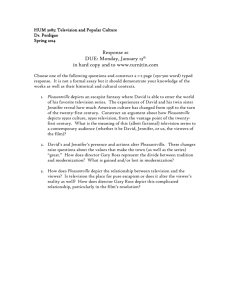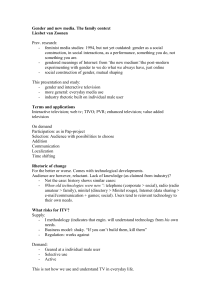dtt_glossary_of_terms - Broadcasting Authority of Ireland
advertisement

Glossary Access Services: In relation to broadcasting, these are services to promote the understanding and enjoyment of programmes by persons who are deaf or hard of hearing and persons who are blind and partially sighted. Audio Description (AD) Audio description is a commentary that gives a viewer with a visual impairment a verbal description of what is happening on the screen, as an aid to the understanding of the programme. The technique uses a second sound track that gives a description of the scene and the onscreen action. Irish Sign Language (ISL) Irish Sign Language is the language of the Deaf community in Ireland. Signing may be presented on-screen through the use of a signer as part of the programme content, or the use of a signer (either a real person or a computer generated person or ‘avatar’) acting as an interpreter in a box position in the corner of the television screen. Subtitles Subtitles are on-screen text that represents what is being said on the screen. Subtitling can be open (remains on the screen at all times) or closed (added to the screen when the viewer wants, for example by using page 888 on Teletext). To improve understanding and accuracy, subtitles can also be colour coded, so that the viewer knows who is speaking in the scene. Analogue Television: Analogue television is a way in which picture and sound information are transported, by means of an analogue signal onto television, for example, from an aerial on your roof-top. Analogue Switch-Off Analogue Switch-Off is the removal existing analogue television services, replacing them with digital terrestrial television services (see later definition of (ASO): DTT). Conditional Access (CA): Conditional Access systems restrict television program access to certain groups of users either because of concerns for privacy or the desire to collect revenue for the service. Providing conditional access requires secure encryption of the program content, secure decryption in a set-top-box (STB, see later definition) for each viewer, and an embedded serial number that is registered in a central conditional access system database. Digital Television: Digital television is a system for broadcasting and receiving moving pictures and sound by means of digital signals, in contrast to analogue signals used by “conventional” TV. Digital signals are compressed, transmitted and decoded into what you see on your television. Data can be decoded by a specially designed television set, or a standard receiver with a set-top box, or a PC fitted with a television card. Digital television has several advantages over traditional analogue television. The most significant one is that digital channels take up less ‘bandwidth’ space. This means that digital broadcasters can provide more digital channels than analogue television; provide High-Definition digital service; or provide other non-television services such as pay-multimedia services or interactive services and electronic program guides. Digital television often has a superior image, improved audio quality, and better reception than analogue. Digital Switch-Over (DSO): Digital Switch-Over refers to the period, and specifically the date, at which analogue television transmission will cease. In Ireland, this has an anticipated date of 2012. At a European level, there is an imperative that this process occurs before 2015. See also definition for Analogue Switch-Off (ASO). Digital Terrestrial Television (DTT): Digital terrestrial television is a way of sending digital signals - pictures and sound - to an aerial. A process called ‘digital multiplexing’ compresses, or squeezes, the digital signal so that it takes up less space than an analogue signal. A box on the viewer’s TV set, known as a set-top box (see later definition), decodes the digital signal received by the aerial so that it can appear as pictures and sound through the person’s television. The main difference between digital and analogue television is that it’s possible to broadcast a number of digital channels in the space that was taken up by a single analogue channel. DTT Receiver: This is the device that processes the incoming signal from the DTT transmitter and turns it into a format which can be displayed on the TV. It can take the form of a set top box (see ‘Set Top Box’ definition) or may be integrated into the TV itself. The essential role of the DTT receiver is to receive, decode and decompress digital data to produce audio and visual signals that can be displayed. It is a custom computer system whose processing power can vary considerably depending on the functionality and sophistication of the receiver. DTT Receiver (cont.): DTT Pilot in Ireland: All receivers use an Operating System to perform its basic functions. Some receivers offer a return path, via a telephone or broadband connection, to allow two-way communication or interaction. This general requires a built in modem and is not a regular feature of most receivers currently on the market. In 2006, the Department of Communications, Marine and Natural Resources1 began work on a DTT Pilot Project which was officially launched by the Minister on 5th March 2007 and will run until August 2008. The Department commissioned a network of three multiplexes at two transmitter sites. The project is targeting between 600-1000 homes and 1 Now called the Department of Communications, Energy and Natural Resources facilitating a range of technical tests. A variety of content is being broadcast, including all of the national free-to-air broadcasting services, with audio services also forming part of the content package on offer. The BCI assisted the Department in the licensing process for the project and continues to participate in the Pilot Stakeholders Group (PSG) for the duration of the project. Electronic Programme Guide (EPG): An Electronic Programme Guide is an on-screen guide to scheduled broadcast television programmes, allowing a viewer to navigate, select and discover content by time, title, channel, genre, etc, by use of their remote control, a keyboard or even a phone keypad. Interactive Television or iTV: There are at least three levels: 1. Interactivity with the TV set via the remote control e.g. for channel surfing or Red Button for related alternative channel selection 2. Interactivity with programme content e.g. audience response back to the show, comments, polling etc. 3. Interactivity with connect related to what is on TV e.g. requesting additional information on an advertised product, purchasing an advertised item etc. Note: All levels beyond level 1 require a telephone or broadband return channel. The word ‘interactivity’ in this document refers to levels beyond level 1. Middleware: Middleware is computer software that connects software components or applications so that they can exchange data. It is used most often to support complex, distributed applications. It includes web servers, application servers, content management systems, and similar tools that support application development and delivery. Moving Pictures Expert Group (MPEG): The group has developed international standards for compressed digital video and audio. MPEG-2 & MPEG-4: MPEG-2 and MPEG-4 are compression standards for video and audio digital data, which permit the storage and transmission of movies using currently available storage media and transmission bandwidth. Compression or Data Compression In computer science and information theory, data compression is the process of encoding information through a specific encoding scheme, using fewer bits (information-bearing units) than an unencoded representation would use. For example, this article could be encoded with fewer bits if the word "compression" were encoded as "comp". As with any communication, compressed data communication only works when both the sender and receiver of the information understand the encoding scheme. For example, this text makes sense only if the receiver understands that it is intended to be interpreted as characters representing the English language. Similarly, compressed data can only be understood if the decoding method is known by the receiver. Compression is useful because it helps reduce the consumption of expensive resources, such as hard disk space or, in the case of digital terrestrial television, transmission bandwidth. MPEG-2 is widely used around the world to specify the format of the digital television signals that are broadcast by terrestrial, cable and direct broadcast satellite TV systems. The standard allows text and other data, e.g. electronic programme guides, to be added to the video and audio data streams. TV stations, TV receivers, DVD players and other equipment are mostly designed to this standard. MPEG-2 & MPEG-4 (cont.): MPEG-4 absorbs many of the features of MPEG-1, MPEG-2 and other related standards, adding new features and a series of technologies for developers, service-providers and end users. It enables developers to improve the quality of services and technologies like digital television, animation graphics, World Wide Web and their extensions. Also, developers can control their content better and protect more against copyright violations. Multiplexing or Digital Multiplexing: Multiplexing is a term used to refer to a process where multiple analogue message signals or digital data streams are combined into one signal. Multiplex or MUX: A Multiplex or MUX is a combined set of signals or data streams. Personal Video Recorder (PVR): Devices that allow TV viewers to time shift, pause and fast forward (until real time) using hard-drive video storage. STB (Set-top Box): The term set-top box describes a device that connects to a television and some external source of signal, turns the signal into content and then displays it on the screen. A set-top box decodes digital signals into signals that analogue televisions can understand. TV sets with built-in digital receivers are known as Integrated Digital Televisions (iDTVs). Video on Demand (VOD): Video on Demand (VOD) refers to a technology that makes it possible for consumers to control the start of a viewed program. For example, by remote control a consumer might pick from an on-screen list of movies and start and pause it at their convenience.







